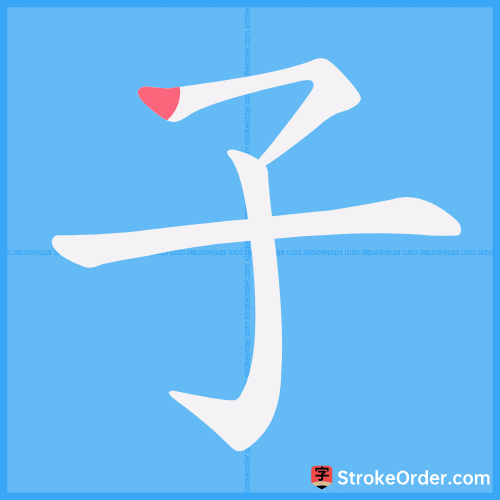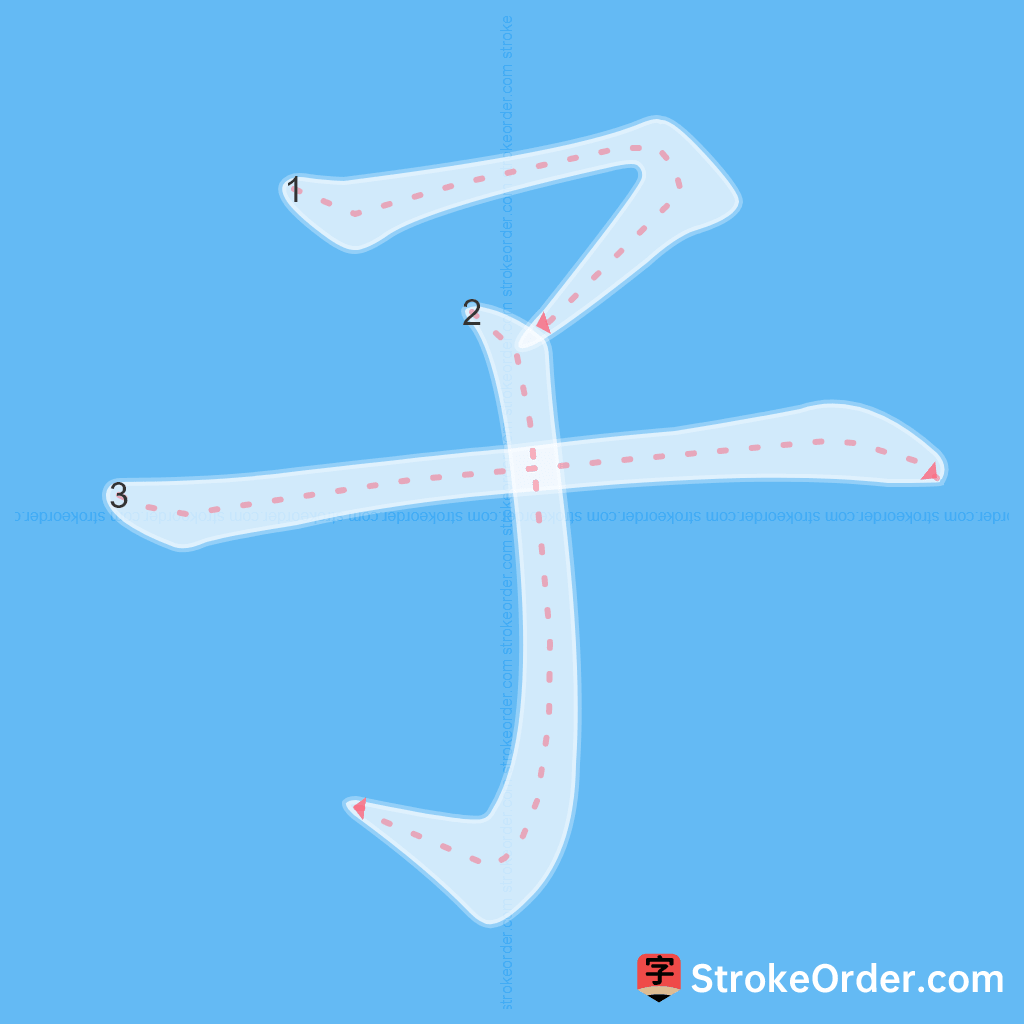子 Stroke Order
Animated Stroke Order of 子

Stroke Order Diagrams for 子

Step-by-Step Handwriting Guide for 子

Learn to Write Chinese Characters with Video Tutorials
Watch the video of writing the Chinese character "子", learn the correct stroke order (笔顺) of the character "子", and master the standard way of writing the character "子".
Free Printable Handwriting Practice with Stroke Order: 子
Printable Writing Practice Worksheet of "子" in Portrait Orientation (Tian Zi Ge)

Printable Writing Practice Worksheet of "子" in Landscape Orientation (Tian Zi Ge)

Information of 子
Pinyin
zǐ、 zi
Radical
子
Strokes
3 strokes
Usage
★★★★★
Definition
11 p.m.-1 a.m. / 1st earthly branch / child / midnight / son / child / seed / egg / small thing, (noun suff.)
子
[zǐ]
[名]
【本义】:婴儿
【造字法】:象形。甲骨文字形,象小儿在襁褓中,有头、身、臂膀,两足象并起来的样子。"子"是汉字的一个部首。
1. 同本义 (English: baby; infant)
2. 儿女。古人称子兼男女 (English: child)
3. 今则专指儿子,即某人直系血统的下一代男性 (English: son)
4. 子孙 (English: descendant)
5. 通常指晚辈直系或旁系血亲 (English: usually referring to direct or collateral relatives)
6. 系另一人或一个共同世系的后裔; 后代 (English: descendants of another person or of a common ancestry)
7. 人的通称 (English: person)
8. 中国古代士大夫的通称 (English: literate and officialdom (in feudal China))
9. 中国古代对男子的通称 (English: man)
10. 古人对自己老师的称呼 (English: master)
11. 地支的第一位 (English: the first of the twelve Earthly Branches)
12. 与天干相配,用以纪年 (English: paired with Heavenly Stems for marking years)
13. 用以纪月,即农历十一月 (English: used in marking months, i.e. the eleventh month in the lunar calendar)
14. 用以纪日 (English: used in marking days)
15. 用以纪时,即夜半十一时至一时 (English: used in marking time, i.e. from eleven to one at night)
16. 专指女儿 (English: daughter)
17. 加在姓氏或数词后面作为对人的尊称 (English: honorific title with the surname)
18. 姓 (English: surname)
子
[zǐ]
[形]
1. 小 (English: small)
2. 嫩的或易咀嚼的 (English: tender)
3. 幼小 (English: young)
4. 属于别人的,受别人控制的 (English: subsidiary)
子
[zǐ]
[动]
1. 通“慈”。爱; 尤指像对子女一样地爱护 (English: love)
2. 收养为子 (English: adopt as son)
3. 结果实 (English: bear fruit)
4. 尽儿女之道; 善事父母 (English: serve one’s parents with filial devotion)
子
[zǐ]
[副]
1. 表示限制,相当于“只” (English: only)
子
[zǐ]
[连]
1. 相当于“虽然” (English: though, although)
子
[zǐ]
[代]
1. 你——尊称对方,通常为男性 (English: you)
2. 另见 zi
子
[zì]
[助]
1. 构词后缀。
2. 加在名词后。
3. 加在动词或形容词词素后。如;胖子;瘦子;垫子
4. 个别量词后缀
子
[zì]
[助]
1. 构词后缀。
2. 加在名词后。
3. 加在动词或形容词词素后。如;胖子;瘦子;垫子
4. 个别量词后缀
(*引自繁体辞典解释)
【綴】
1. 词尾:➊ 接名词。如:「桌子」、「筷子」。➋ 接动词。如:「起子」、「拍子」。➌ 接形容词。如:「聾子」、「亂子」。➍ 接量词。如:「兩下子」、「一檔子」。
Input Method for 子
Pinyin
zi3
Wubi
bbbb
Cangjie
nd
Zhengma
ya
Four Corner
17407
Unicode
U+5b50
Same Pronunciation Characters